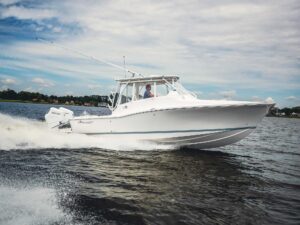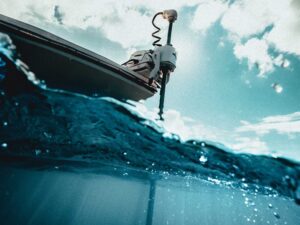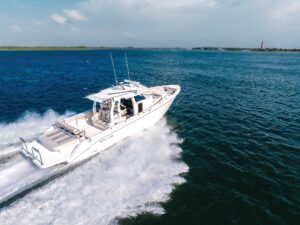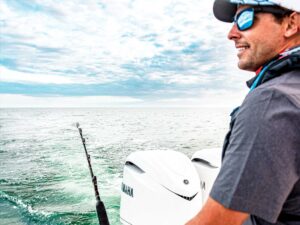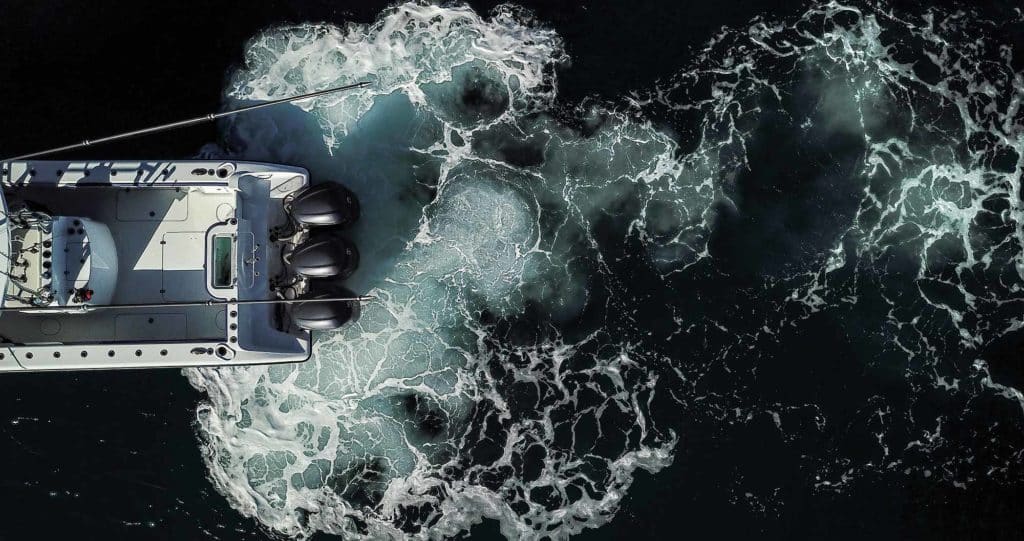
Surrealistic car commercials: Driver dials a knob on his dash and his pickup truck precisely and skillfully backs his trailered boat. Guy pushes a button and his luxury vehicle parallel-parks itself — hands-free.
That same kind of abracadabra control has come to boats, and it’s beginning to have a significant effect on fishing. Anglers can crank their outboards with the touch of an app button, from halfway down the dock, and once aboard spin away using a light touch on the joystick control.
Outboard and steering-system manufacturers have even created a one-push command to employ a virtual anchor so anglers can jig up bait around a buoy or drop rigs to a wreck or reef without constantly jockeying for position with the throttles and wheel. Guys can ask their engines to hold heading for a kite-fishing drift, maintaining baits and gear in optimal positions.
Those of us “of a certain age” experience a creepy Orwellian sensation when we see this electronic voodoo. Others just marvel, mouth agape, at the technology.
Like most cutting-edge products, the systems that enable these outboard tricks — Yamaha‘s Helm Master, Mercury‘s Joystick Piloting and SeaStar‘s Optimus 360 — cost a pretty penny. But as these technologies have matured over the past five years, prices have at least started to drop. Most now cost $15,000 to $20,000, plus installation.
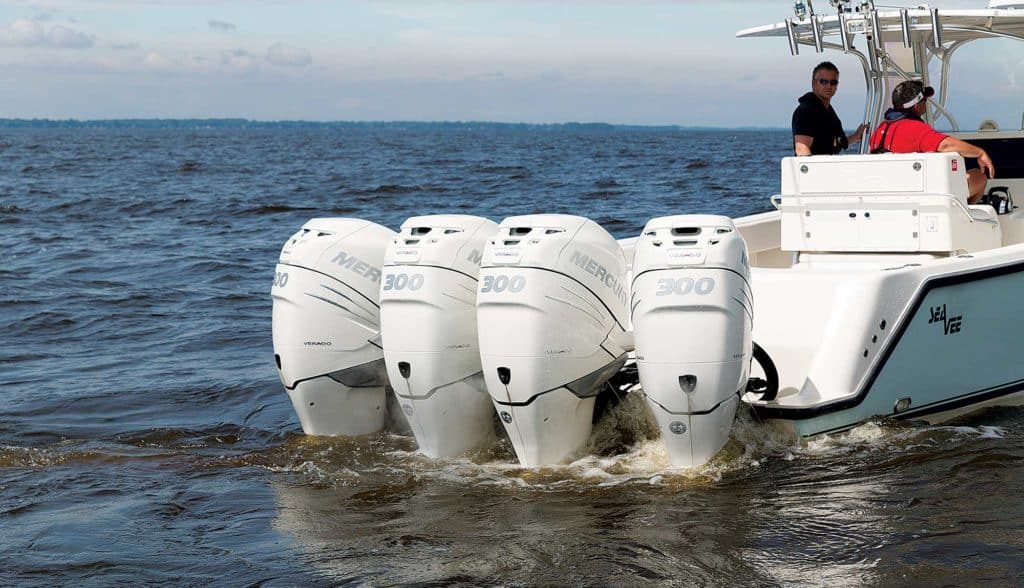
Outboard Control Features
“Originally, we were only factory installed. You would go to a [boat] dealer and buy a boat either with or without Helm Master,” says Ry Landry, Yamaha marine product and information specialist. “Now, we’re offering it as a dealer-installed option. Customers with a boat that’s a year or two older can have Helm Master retrofitted.”
Outboard companies are also starting to add new features to their outboard-control systems, using simple software downloads. Mercury’s latest Heading Adjust, BowHook and DriftHook features can be purchased by the boat owner online for $49 to $449. (Often a Mercury dealer must update the firmware on the joystick system to use these features.)
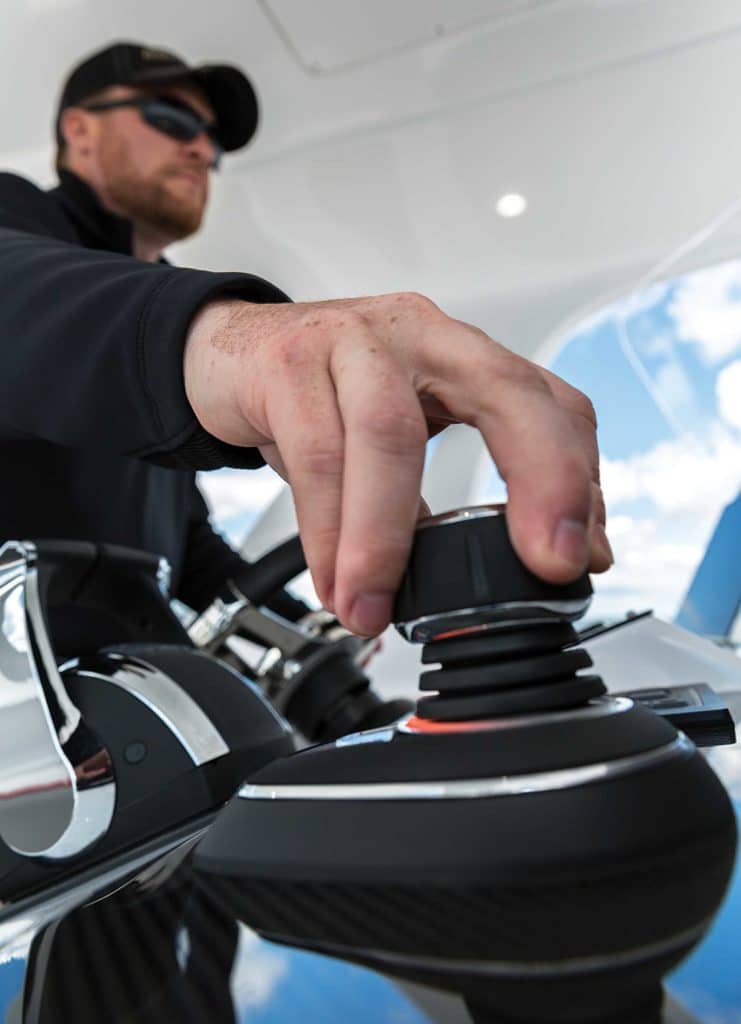
When SeaStar adds the SeaWays Autopilot feature (expected early this year), it will be a free software update installable by dealers.
“Some of these systems were designed years ago for inboard and sterndrive boats,” says Dan Balogh, director of electronics and controls engineering for Mercury, which debuted its Zeus joystick system for inboard pods in 2007 along with the first virtual-anchor system, Skyhook, and autopilot. “They’ve migrated to outboards and more toward fishing. Fishermen are the biggest users of this.”
The most recent station-keeping features, which include multiple modes for holding position, heading, or position and heading, rolled out recently, starting with SeaStar’s SeaStation in 2016, followed by Yamaha’s Set Point and Mercury’s Skyhook Advanced Features in 2017.
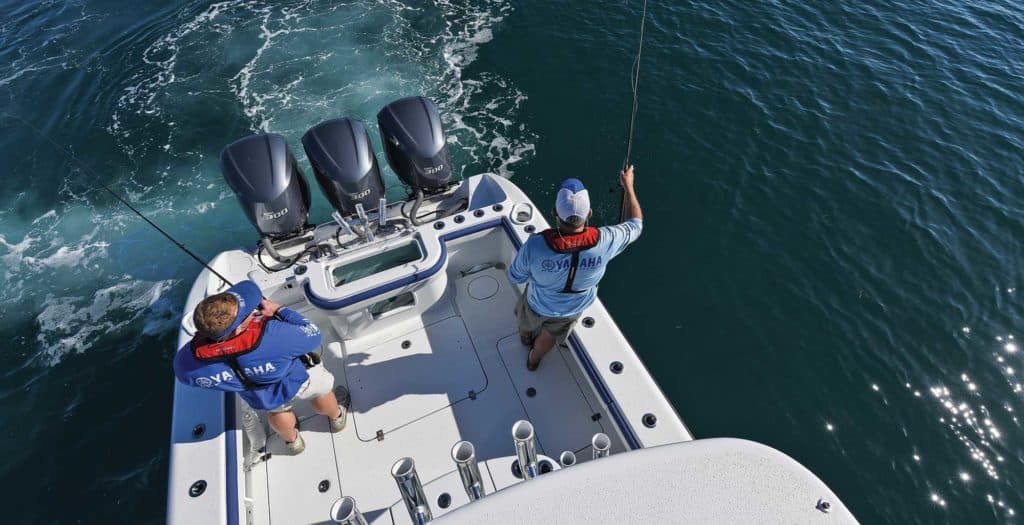
Yamaha Highlights
“I hate change. But this has made me such a better fisherman, it’s not funny,” quips Capt. George Mitchell, a longtime tournament angler out of Florida who has been using Yamaha’s Set Point features with Helm Master since those updates were announced last February. “The more I do this, the more I come up with different tactics.”
Yamaha’s Set Point system includes four functions:
Stay Point: Holds the boat’s position and heading. Best used when you must hover above a specific location without swinging or drifting. This function generates more white water and noise, which can be helpful or harmful for fishing, depending on the situation.
Drift Point: Holds the boat’s heading but not position. The bow maintains its orientation while the boat drifts with the current or wind.
Fish Point Bow: Holds the boat’s position with the bow pointed into the wind/current, using the water- or airflow to maintain heading.
Fish Point Stern: Holds the boat’s position with the stern to the wind/current, again using water- or airflow to maintain heading.
“I advertise this system as the ultimate first mate,” Mitchell continues. “I can tell it to keep the nose into the wind or nose into the current or spin the boat just a little.”
But Mitchell is quick to point out, as were all the other captains and manufacturer reps we talked with, that having these functions is not an excuse to leave the helm. “Someone’s always at the helm for safety and because of changing conditions,” he says. “I want to be able to monitor depth too.”
Stay Point is the function Mitchell uses when he truly needs holding power and when he wants to create white water and commotion. “Stay Point is the most aggressive of all the features. It uses all the attributes: full thrust, steering and gear shifting. That allows you to hold heading and orientation in more adverse conditions.”
For instance, when fishing a location such as the St. Simons Island, Georgia, ship channel, the tidal current usually rips. “Let’s say we have 2 to 4 knots of outgoing tide and 15 knots of incoming wind,” he says. “We want to put a [blue] runner on a kite off the edge of the channel to entice that 40-pound kingfish. How do we do that?”
Mitchell says he always conducts a test drift, what he calls a “benchmark” drift. In this case, he wants to know which is stronger: wind or current. He must judge how to position his 36-foot Yellowfin, with triple Yamaha F300s, before engaging Stay Point. “If conditions allow, what I want to do is put more baits out.”
The noise and commotion that Stay Point can create can be advantageous in certain situations, such as near Gulf of Mexico oil rigs. Cobia respond curiously to new sounds. Turbulence can attract other fish as well.
However, the noise could spook fish in shallow water, so Yamaha, as well as its competitors, has developed lower-rpm modes. Yamaha’s Drift Point and Fish Point offer those alternatives, as do SeaStar’s Position Hold and Heading Hold, and Mercury’s BowHook and DriftHook.
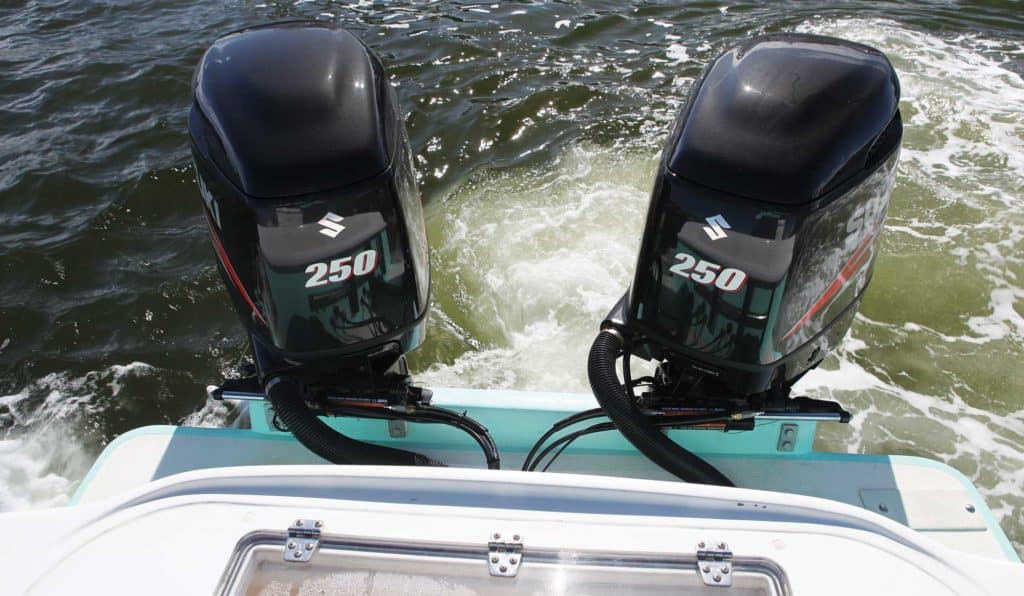
SeaStar Updates
“When we were doing our investigative work to develop the modes for SeaStation, we spent time with charter captains to see how they would most benefit,” says Shane DeWitt, electronics product manager for SeaStar. Captains wanted to use the system without spooking fish and without shifting the engines more than necessary to manage wear and tear on the gear system.
“So, we wanted to do everything we could to minimize shifting. And if you’re shifting, do it at low rpm,” DeWitt says. “Fishermen need to hold position. They’re not too concerned with heading.”
SeaStar’s Position Hold uses the boat’s most natural heading and modulates the throttle to the engines, moving them with minimal shifting to get the desired performance. The boat hovers over a location but can rotate with the wind or current.
For kite-fishermen, SeaStar developed Heading Hold, which holds the boat in one direction and allows it to drift with the wind and current. SeaStar also offers Heading and Position Mode for those times when the vessel must remain stationary.
Mercury developed BowHook and DriftHook as extensions of its original Skyhook virtual anchor for holding position and heading.
Read Next: Twin Outboards Versus Single Outboard
“If you’re in an area where there’s some structure and you want to reduce white water, you put the boat in BowHook. The boat will hover over that spot while it takes a heading [based on wind and current],” Balogh says. “DriftHook allows the boat to drift while holding your heading. That helps keep lines from tangling.
“Heading Adjust is actually my favorite feature. It allows you to fine-tune your spot,” he says. If your heading isn’t quite right in Skyhook, based on existing weather conditions, you can adjust heading lock in 1- and 10-degree increments. (SeaStation can change heading by the same amounts with the tap of the joystick.)
Mitchell uses Yamaha’s low-rpm modes when current and wind conditions diminish and when he wants to catch bait at buoys, drift a wreck or fish multiple kites. “I love to drift, love to prospect. That’s where Drift Point comes in,” he says. “What we wanted most was to be able to drift at the mercy of the conditions and to change the boat’s orientation to make it easier to present more baits.”
As always, Mitchell starts with a benchmark drift to gauge how the boat will float over structure or between waypoints. If, for instance, the boat naturally faces southwest because of wind direction while it’s drifting north, that can create a hazard.
Because he has placed the rods in holders facing aft, the lines now exit the rod tips at a sharp angle. But if he engages Drift Point, he can swing the bow to a more amenable position and then deploy more baits.
Mitchell acknowledges that such maneuvering alters course over ground. But often, it improves a drift, lining up the boat better with a series of reefs or waypoints, for instance. As he fishes, he keeps the tracking function on for his Furuno electronic displays. If he wants to modify the drift, he can orient to the track line on the next drop.
Fish Point Bow comes in handy for catching bait at a sea buoy, such as the one outside Palm Beach Inlet, he says. With 15 knots of southeast wind and 2 to 4 knots of northbound current, “it’s going to be a bit of a bear to go up to the sea buoy without negotiating a lot with the motors,” he says.
“What I like to do is get 100 to 150 feet away to the north and see the course and drift. Nine times out of 10, sardines will be on the front side of the buoy. I’ll get in front of the buoy and do Fish Point Bow, setting my heading at 140 degrees.”
Mitchell says he likes Fish Point Stern for bottomfishing in light current. When fishing a wreck, for instance, he moves up-current from the structure and turns the stern into the current. Once he hits Fish Point Stern, he can then fish multiple lines and anglers all around the boat and keep baits in the strike zone.
“In the Fish Point mode specifically, you can set an upper limit for rpm,” Yamaha’s Landry adds. “This is made for structure fishing. An angler can set the rpm limit as high as 2,500 or as low as 900.”
Using these systems, anglers no longer have to rely on an anchor that allows the boat to swing side to side, Mitchell says. “With Fish Point Stern or Fish Point Bow, all you have to do is jog the joystick to adjust the boat. You’re not having to pull the anchor to reposition. That scares people away from fishing.”
An anchor can also hinder anglers who hook up to a really big fish only to have it spool them while they wait for the captain to throw a buoy or pull the hook. Hooked fish can also become tangled in an anchor line.
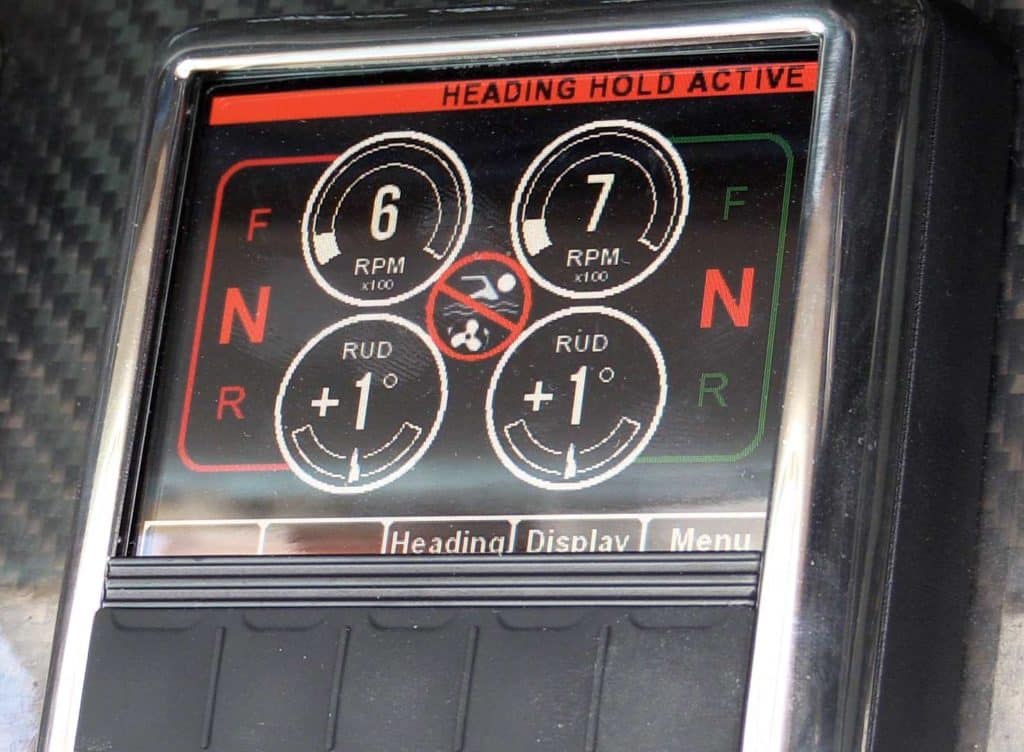
Engine Setups
SeaStar’s SeaStation system integrates (at no charge) with the company’s Optimus 360 joystick steering package, which is compatible with twin-, triple- and quad-outboard applications for Suzuki, Evinrude and Yamaha products as well as twin mechanical Hondas. In triple and quad situations, SeaStar uses tie-bars to connect two engines together for synchronicity.
Boatbuilders can install Optimus 360 at the factory on new boats. SeaStar has also trained more than 245 dealers around the country to install and service the system after market.
Yamaha’s Helm Master works with the company’s own twin, triple or quad outboards, and each engine operates independently.
Mercury’s Joystick Piloting and Skyhook Advanced Features pair up with that company’s 250 to 400 hp Verado outboards in twin, triple or quad configurations. Some quad installations require tie-bars.
Balogh explains that in twin-outboard setups, one engine usually works in reverse while the other moves forward — at varying rpm and steering angles — allowing the boat to move in any direction from center.
Read Next: Selecting the Best Outboard Motor
With triple Mercury configurations, the center engine follows whichever outside engine is working in reverse. “Props are designed to go forward,” he says. “A prop in reverse has less bite, so the center engine helps the engine that has the weaker force.”
With quadruple Mercury outboard setups, the two port engines might be tie-barred together, with regular and counter-rotating props. Ditto the two starboard engines. “It’s like a big dual [engine]. The net effect is you have a lot of authority.”
Mercury also now builds its outboards to be joystick-ready, Balogh says. “There are certain features in the exhaust and the electronics on board that make better-performing joystick control compared with systems added after the fact.”
These station-keeping and joystick systems all function similarly, employing a GPS sensor and other instruments mounted on the boat’s hardtop, several computers and devices such as inertial measurement units and digital compasses at the helm. The system computers communicate with the engine control units, usually via a CAN bus, a controller area network for that specific purpose.
While the engineering might sound complex, the outboard companies and SeaStar Solutions have kept the user interface as simple as possible. Minimal buttons on the joystick control the features, and a sophisticated gauge display provides easy-to-understand alerts and notifications.
Future Outboard Options
Outboard companies won’t say what features they might be working on next for station-keeping systems. SeaStar will soon roll out its SeaWays autopilot function, allowing captains to transit to a waypoint or follow a track using the Optimus 360 system.
Anglers who operate single-engine boats wonder about any applications for their vessels, though without two props in the water, thrusters or a rotating lower unit, engineers really can’t create the necessary opposing forces.
“We’re always working on new things.” That’s all Mercury’s Balogh will say. “There’s a lot of interest in the joystick in general. We’re happy with the position we’re in right now.”

